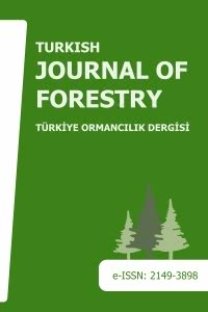Coğrafi bilgi sistemleri tabanlı rota planlama: Likya Bölgesi Idebessos Antik Kenti
Idebessos antik kenti, Doğa yürüyüşü rotası, Alternatif turizm, CBS, Uygun güzergâh analizi
Route planning based on geographical information systems: Idebessoss Ancient City in Lycia
Idebessos Ancient City Trekking route, Alternative tourism, GIS, Least Cost Path Analysis, Least Cost Path Analysis,
___
- Bhattarai, K., Conway, D., Shrestha, N., 2005. Tourism, terrorism, and turmoil in Nepal. Annals of Tourism Research, 32 (3): 669-688.
- Briassoulis, H., 2002. Sustainable tourism and the question of the commons. Annals of Tourism Research, 29 (4): 1065–1085.
- Campbell, L., 1999. Ecotourism in rural developing Countries. Annals of Tourism Research, 26: 534–553.
- Cater, E., 1993. Ecotourism in the third world: problems for sustainable tourism development. Tourism Management, 14 (2): 85-90.
- Çoban, H.O., Eker, M., 2010. Analysis of forest road network condition before and after forest fire. FORMEC 2010, Forest Engineering: Meeting the Needs of the Society and the Environment, July 11 – 14, Padova – Italy, s.11.
- Davidson, D.J., 2010. The applicability of the concept of resilience to social systems: Some sources of optimism and nagging doubts. Society and Natural Resources, 23: 1135-1149.
- Fitzpatrick, C., Maguire, D. J., 2000. GIS in Schools: Infrastructure, Methodology and Role. In: Green, D.R.( Ed.), GIS: A Sourcebook for Schools, Taylor & Francis, pp. 62-72.
- Gabdrakhmanov, N.K., 2016. Historical and cultural heritage in tourism development: The case of Republic of Tatarstan. International Business Management, 10 (22): 5273-5279.
- Gyimóthy, S., Mykletun, R. J., 2004. Play in adventure tourism: The case of Arctic trekking. Annals of Tourism Research, 31(4):855-878.
- Hunter, C., 1997. Sustainable tourism as an adaptive paradigm. Annals of Tourism Research, 24 (4): 850-867. Ismagilova, G.N., Safiullin, L.N., Bagautdinova, N.G., 2014. Tourism development in the region based on historical heritage. Life Science Journal, 11-6.
- Jones, S., 2005. Community-based ecotourism, the significance of social capital. Annals of Tourism Research, 32 (2): 303–324.
- Kervankıran, İ., Çuhadar, M., 2014. Turizm rotalarının oluşturulmasında coğrafi bilgi sistemlerinin önemi. III. Disiplinlerarası Turizm Araştırmaları Kongresi, 4-5 Nisan 2014, Kuşadası, Aydın, ss. 576-589.
- Kızgut, İ., Bulut, S., Çevik, N., 2009. An East Lycian City: Idebessos. Adalya, 12: 145-72.
- Lee, T.H., 2013. Influence analysis of community resident support for sustainable tourism development. Tourism Management, 34: 37–46.
- Lee, J., Stucky, D., 1998. On applying viewshed analysis for determining least-cost paths on digital elevation models. International Journal Geographic Information Science, 12 (8): 891–905.
- Nyaupane, G.P., Lew, A.A., Tatsugawa, K., 2014. Perceptions of trekking tourism and social and environmental change in Nepal's Himalayas. Tourism Geographies, 16 (3): 415-437.
- Rees, W.G., 2004. Least cost paths in mountainous terrain. Computers & Geosciences, 30: 203-209.
- Sarı, F., Şen, M., 2017. Least cost path algorithm design for highway route selection. International Journal of Engineering and Geosciences, 2 (1): 1-8.
- Shankar, H., Mani, G., Pandev, K., 2014. Gis based solution of multi-depot capacitated vehicle routing problem with time window using tabu search algorithm. Int. J. of Traffic and Transportation Engineering, 3(2): 83-100.
- Weinberg, A., Bellows, S., Ekster, D., 2002. Sustaining ecotourism: Insights and implications from two successful case studies. Society and Natural Resources, 15: 371–380.
- ISSN: 1302-7085
- Yayın Aralığı: Yılda 2 Sayı
- Başlangıç: 2000
Ahmet TOLUNAY, Özgür BALCI, Türkay TÜRKOĞLU
Mehmet Güvenç Negiz, Esra Özge Kurt, Özdemir Şentürk
Coğrafi bilgi sistemleri tabanlı rota planlama: Likya Bölgesi Idebessos Antik Kenti
Serdar SELİM, Namık Kemal SÖNMEZ
Türkiye’de doğal yayılış gösteren herdem yeşil meşe (Quercus L.) türlerinin anatomik özellikleri
Kuraklık stresli Quercus cerris fidanlarının fizyolojik ve biyokimyasal özelliklerindeki değişimler
Ebru Hatice TIĞLI, Hüseyin Fakir
Doğu ladini (Picea orientalis) ve meşe (Quercus spp.) kabuklarının kimyasal bileşimi
Oktay GÖNÜLTAŞ, Mualla BALABAN UÇAR
Huseyin YORUR, Kadir KAYAHAN, Muhammed Nuri GÜNAY, Suat ALTUN, Belgin ŞEKER
Ahmet Ali VAR, Ömer Ümit YALÇIN, Abdulkadir SOYGÜDER
Antalya Göynük Yöresinde hibrit Phlomis x termessi P.H. Davis üzerine araştırmalar
